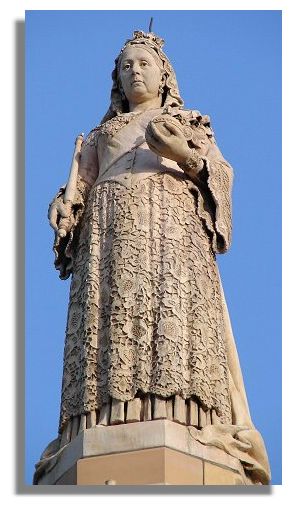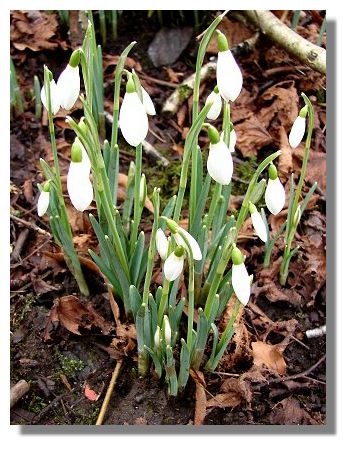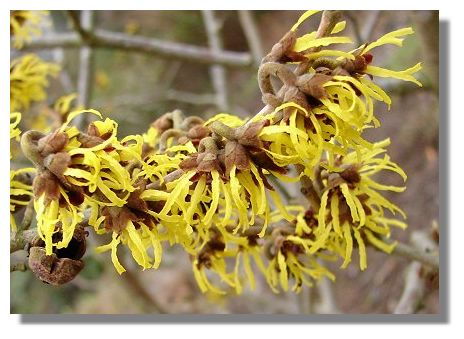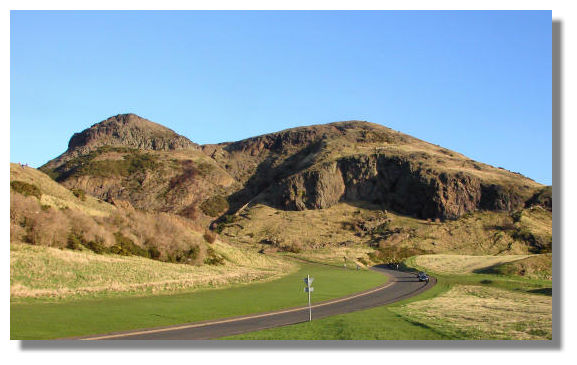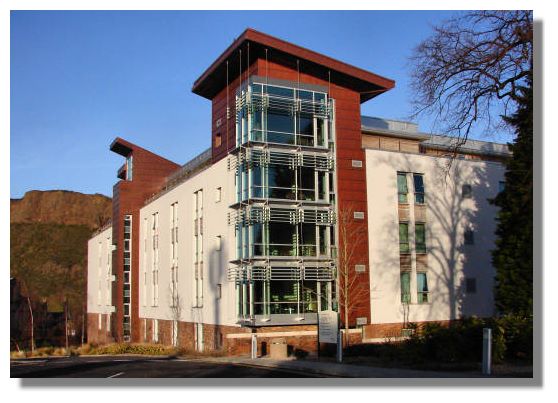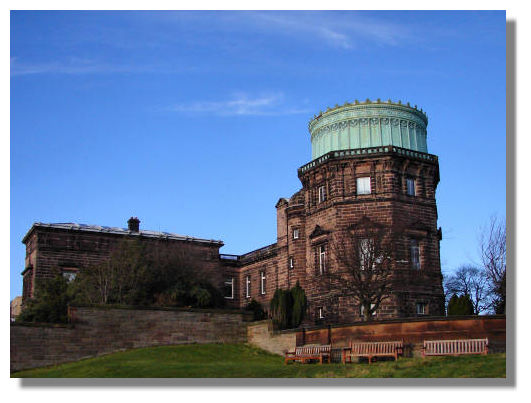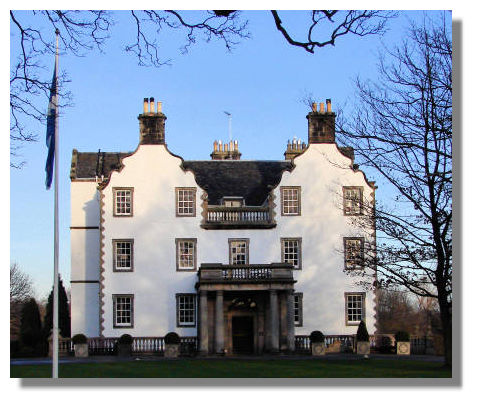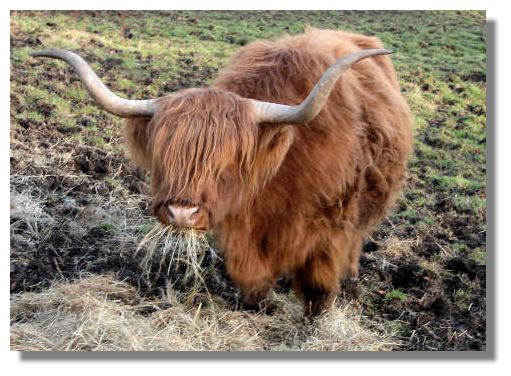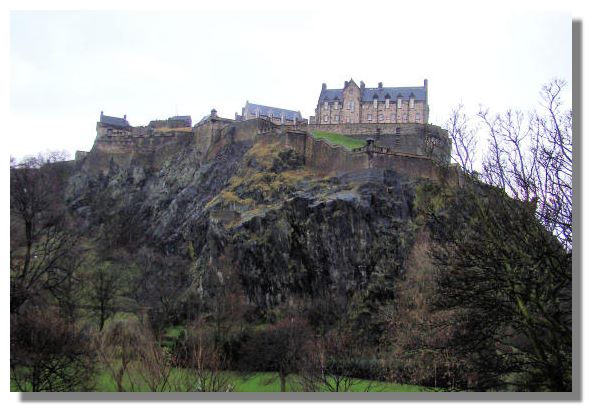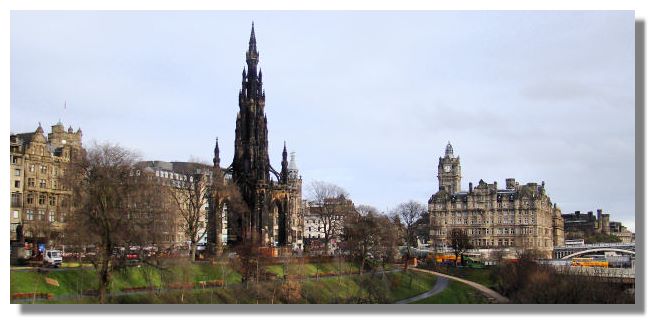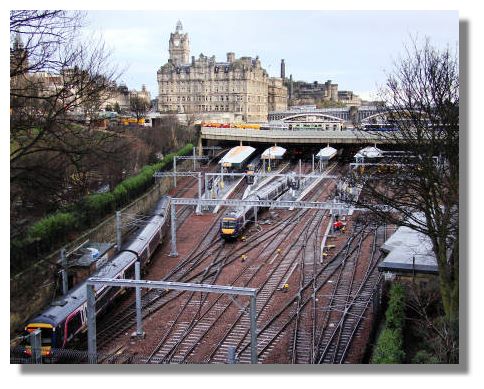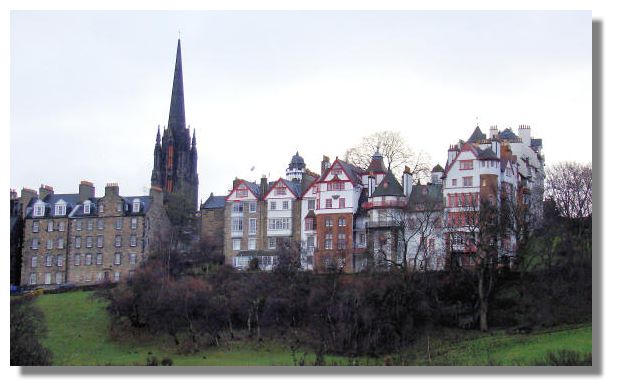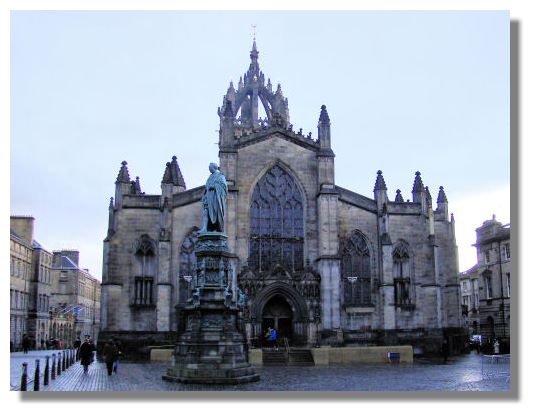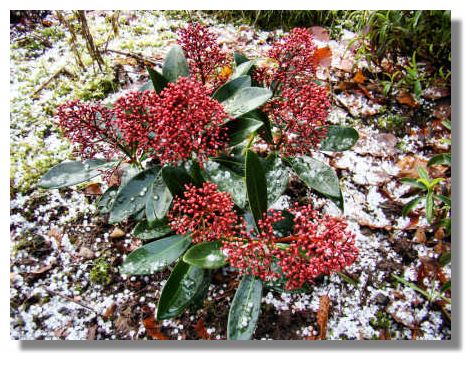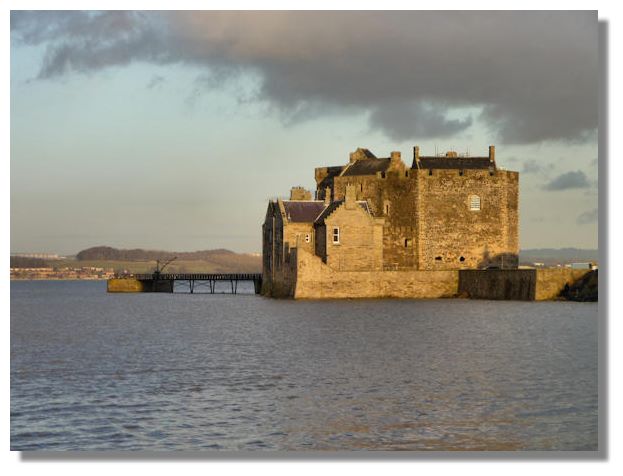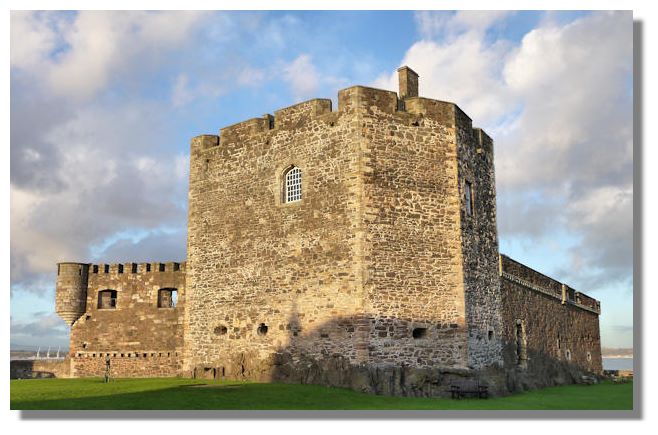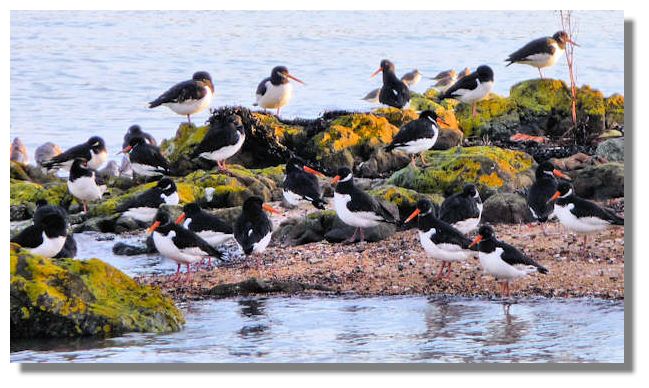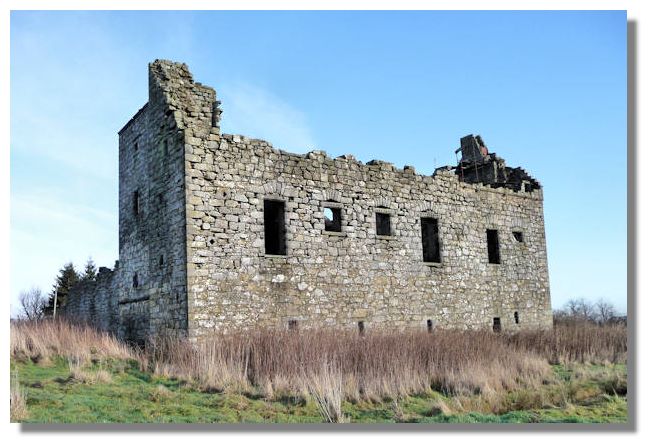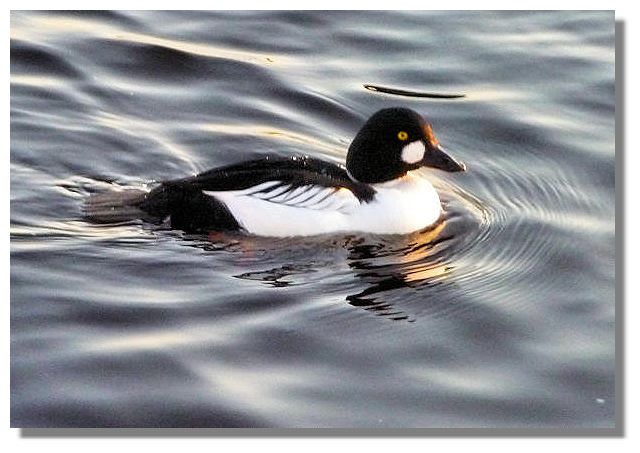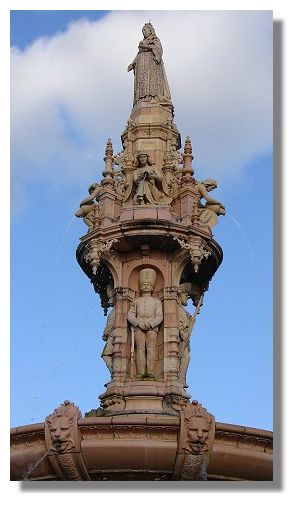
The sun was shining brightly when this photo of the magnificently restored Doulton Fountain was taken. The fountain was gifted to the city by Sir Henry Doulton to commemorate Queen Victoria's Golden Jubilee of 1887 and it was first unveiled at the Empire Exhibition held at Kelvingrove Park in 1888. It was then moved to Glasgow Green in 1890. Described as a "sculptural extravaganza" it celebrates Britainís Imperial achievements and is crowded with figurative groups representing Australia, Canada, India and South Africa. There are national flora and fauna (South Africa's full size Ostrich, Australian sheep and Canadian Beaver), plus military and naval figures on all four sides, including a kilted highlander. Other decorations include gargoyles, lion masks, coats of arms and life-size girls pouring water over the figures below. At the apex, is a wonderfully detailed and lifelike statue of the queen empress herself (see also below).
The whole assembly is the largest terracotta fountain in the world, with five tiers, rising 46 feet high and 70 feet across at the base. It was largely forgotten (and neglected) on Glasgow Green until the 1990s by which time it was in a sorry state as a result of vandalism - and the fencing which attempted to slow the process of disintegration. Thanks to National Lottery funding and a realisation in the City Council that it had a tourist gem and the best surviving example of its kind on its hands, it was dismantled, restored and relocated to a position outside the People's Palace Museum on Glasgow Green in 2005.
These snowdrops encourage us with the thought that Spring is just round the corner - even if they are not fully opened. The picture was taken at Finlaystone Country Estate in Renfrewshire. The owners are so confident that they will have the usual masses of snowdrops in the woods in a few weeks time that their special "Snowdrop Sunday" is scheduled for mid February.
The unusual, bright flowers of Hammamelis (Witch Hazel) bring colour to gardens in the middle of winter. The crinkled petals resist the hardest of frosts and have a faint perfume.
The vibrant colours of this Poinsettia were photographed - appropriately enough - inside the Winter Garden at Glasgow Green. There is a pleasant cafeteria there where visitors to the People's Palace Museum next door can warm up with a plate of hot soup and/or coffee and cakes, while admiring the plants.
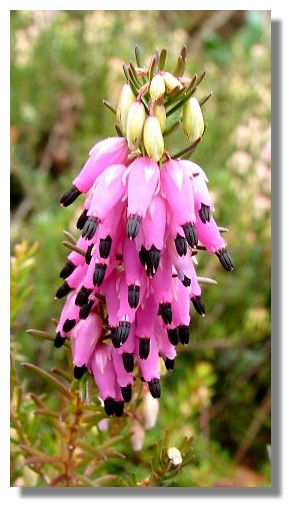
Heather can flower at all times of the year and this one was making a bright splash of colour in Finlaystone Country Estate.
Edinburgh is indeed fortunate to have Holyrood Park overlooking the centre of the Capital. It has been a Royal Park probably since the 12th century and is still technically owned by the monarch - but the hills and pathways are now very much a public park. It covers 650 acres with natural rock formations such as Arthurs Seat and Salisbury Crags visible for miles around. It was the father of modern geology, James Hutton, who first demonstrated that the rocks had been molten magma which had been thrust up to form the igneous sill.
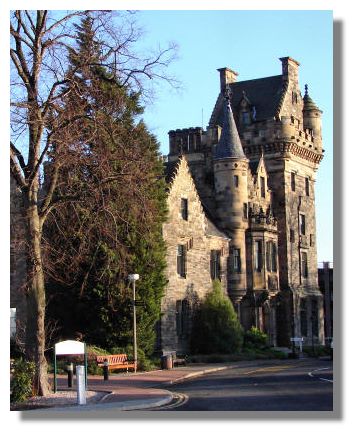
Edinburgh University's student accommodation at Pollok Halls were originally housed in St Leonard's Hall, seen here. Built in 1869, the Scottish baronial style mansion is now used as an administration centre for what is now a large number of student residential buildings.
The latest of the student halls of residence in the complex is Chancellor's Court, which was built in 2003, designed by Oberlanders Architects, an Edinburgh-based company. It provides accommodation for 526 students during term time and is used for commercial activity during the vacation period. You can just see the hills of nearby Holyrood Park and Salisbury Crags on the left of the picture.
The bold Italianate style Royal Observatory at Blackford Hill, two miles south of Edinburgh city centre, was built in 1892. It is still at the forefront of astronomical research, though these days the telescopes are more likely to be remotely controlled in the Canary Island or Chile, with on-line connections with Edinburgh. The surrounding area of Blackford Hill is now a nature reserve and also offers splendid views across the city.
Prestonfield House, nestled against the backdrop of Holyrood park and Arthur's Seat, was built in 1687 on the remains of a villa burnt down in 1681 during an ant-Catholic riot. It has delightful Dutch gables and balustrades. Internally, many of the original painted leather, tapestry and panelled walls remain. It is now an up-market hotel, with an adjoining golf course.
There is always something appealing about Highland cattle. Perhaps it is their long hair (to protect them from the harsh Scottish winters) or their slow and stately movements - I've never yet seen a Highland cow break into a trot, far less a run! This one was steadily munching some hay in a field beside Prestonfield House. Unlike many other animals, there is never any problem getting Highland cattle to pose for a photograph...
Here is a wintry-looking Edinburgh castle, with grey skies and the rocks glistening in the rain. In the summer time, Princes Street Gardens below are often bustling with a mixture of tourists and office workers - but there were few folk walking through on the day this photo was taken.
The Scott Monument in Princes Street Gardens is open all year round - but it can be a bit chilly in January walking round the open observation decks. The five-star Balmoral Hotel is located beside Waverley Station, the main railway terminus in Edinburgh. The Balmoral was built originally as the North British Hotel and opened its doors for the first time on October 15, 1902. The clock is traditionally kept two minutes fast - to ensure that tardy travellers hurry up and catch their train.
If a railway company came along today with a plan to run a busy railway line below Edinburgh Castle, through Princes Street Gardens and build the city's largest station below the "Old Town" of the city, conservationists would have a fit. But in Victorian times, that was exactly what they did. Fortunately, the tracks to Waverley station were built in a deep cutting, so many visitors are unaware that the trains are there - except when the trains give a blast or their horns! In the days of steam trains it was odd to see smoke billowing up below the castle!
To the left of the castle (looked at from Princes Street below) and adjoining the castle's forecourt or esplanade, are the elegant houses of Ramsay Gardens. The delightful jumble of different architectural styles was conceived in the 18th century, with 19th century additions. The development takes its name from Allan Ramsay Snr, who started out as a wig-maker but became a poet and bibliophile. His "Goose-pie" house is an octagonal shape while the flat created by Sir Patrick Geddes, the father of town planning, has a 360-degree panoramic view.
Every time I go to take a photo of St Giles cathedral, it is either surrounded by scaffolding for its latest refurbishment, or there are contractors' vehicle parked along the frontage. So even though it was a dull, overcast sky, I immediately took this photograph - before the workmen came back again!
Hailstones on the ground provide an unusual backdrop for the flowers of this Skimmia Japonica in my own garden.
Located at a natural harbour, which served the Palace of Linlithgow four miles inland, Blackness castle is surrounded on three sides by water. The castle is often referred to as "the ship which never sailed." Visitors can wander around inside the castle, climb the stairs to the top of the tower, see the stone fireplaces which provided the heating in winter (and the dungeons where there was no fireplace or windows) and walk the castle walls and the pier jutting into the water, with a view of the Forth Rail and Road bridges over the river a few miles away.
Handily located a few miles west of Edinburgh, Blackness Castle on the Firth of Forth was built in the 15th century by the powerful Crichton family. It became a royal residence when King James II annexed the lands and it was later to serve on a number of occasions as a prison. High ranking captives included Cardinal Beaton, Archbishop of St Andrews in 1543. The castle became a formidable stronghold with thickened walls and defensive guns. The garrison at the castle held it in support of Mary Queen of Scots for six years. It was besieged by Oliver Cromwell in 1650 and the more powerful guns of those times left the castle in ruins. It was restored during the Napoleonic wars when it again acted as a prison.
Peering over a wall beside Blackness Castle, I came across a large party of mainly Oystercatcher birds. They always look incongruous with those large orange-red bills - useful for digging up not just shellfish at the seashore but also worms inland in farmland. In winter, many develop a white "chin-strap" and their loud piping "kleep-kleep" call can often be heard long before they are seen. They often gather together like this in winter time on coastal shallows and estuaries such as the Firth of Forth. In winter, resident numbers of around 80,000 in the UK swell to over 340,000 as birds from Scandinavia migrate here.
Torwood castle, near the village of Torwood, in the Falkirk Council area of central Scotland, is thought to have been built around 1566 for Sir Alexander Forrester of Garden. It was once the seat of Clan Forrester and was built by the Lords Forrester, who supplied the Crown with timber and were appointed heriditary keepers of the nearby King's Royal forest of Tor Wood by James III (1437-1460). In the early 17th century, the castle passed to the Baillies and then the Forresters of Corstorphine (now part of Edinburgh) in 1653. Torwood is a Scottish Baronial style castle with a three-storey main block facing south and a five-storey wing projecting northwards, with a square stair-tower projecting from the two. The castle was acquired in 1957 by a Glasgow accountant who single-handedly began a slow restoration over the next 40 years. It is now under the auspices of the Torwood Castle Trust.
The Goldeneye duck gets its name from that distinctive yellow eye - though the white patch below the eye of the male bird is even more prominent. The birds nest in trees several metres off the ground and at a day old the chicks (often 8 to 11 of them) jump to the ground where the female marches them off on a perilous journey to a loch which is often a substantial distance from the nesting site. Once there, the young birds dive and feed themselves, becoming independent after about 50 days - and taking to the air for the first time about a week later. In winter, the birds move south - returning to the Lowlands of Scotland and further south.
If you want to look back at other editions of these photos of Scotland week by week, there is an Index Page

Where else would you like to go in Scotland?


